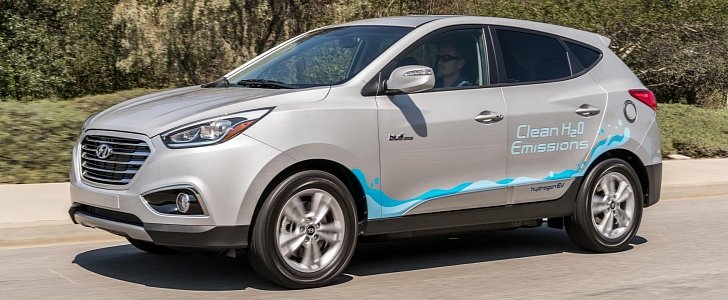Hyundai Tucson Fuel Cell owners in California have driven a total of 1.5 million miles with zero emissions. This is a significant milestone for hydrogen-powered vehicles, but also for Hyundai, which has delivered over 125 Tucson Fuel Cell units since it introduced this model in the USA, back in 2014.
Hyundai estimates that the 1.5 million miles (2.4 million kilometers) driven by its customers on hydrogen power have saved the Atmosphere of approximately 575 tons of CO2 emissions, which would have been emitted if their clients would have driven comparable vehicles that ran on fossil fuels.
It is relevant to remark that the cumulative mileage mentioned by Hyundai refers to cars operated by regular customers, that have agreed to share their data with the automaker for fuel cell stack maintenance.
The first clients of these cars have the opportunity to experiment a new propulsion system, so every mile they drive and their feedback on how the cars operate are vital for the automakers that have built their cars.
In case you are not accustomed to a fuel cell vehicle, it is powered by electric motors that get their energy from what is known as a “fuel stack.”
The said component turns hydrogen from the vehicle’s high-pressure tank into electrical energy. Interestingly, these vehicles have tailpipes, but they only emit water, which is clean enough to drink safely.
The best part about hydrogen fuel cell vehicles is that they can get a refuel in just five minutes or less, which is just as fast as a typical automobile that is powered by fossil fuels.
In other words, you get to refuel an Eco-friendly car just like a conventional one, just as fast, and without depending on international oil quotations.
We must note that this has a significant downside when compared to regular cars – there is no possibility to refuel from a “jerry can.” This restriction exists because the fuel station operates with high-pressure tanks, which have a level of pressure that is about 150 times higher than the one you would have in a typical car tire.
Hydrogen Fuel Cell vehicles cannot be plugged in to charge their batteries at electric charging points, because they use smaller batteries than EVs, and that would make the Fuel Stack into a range extender instead of the primary power source.
However, the 265-mile range between fill-ups is enough to curb range anxiety, and an accurate fuel gauge should keep you on the safe side while driving.
The other downside of these vehicles is that hydrogen fuel stations are not that common these days, but they might become as popular as gas stations some day. It all depends on what technology will get a bigger range across a broad portfolio of cars and gets successful adoption from the public.
It is relevant to remark that the cumulative mileage mentioned by Hyundai refers to cars operated by regular customers, that have agreed to share their data with the automaker for fuel cell stack maintenance.
The first clients of these cars have the opportunity to experiment a new propulsion system, so every mile they drive and their feedback on how the cars operate are vital for the automakers that have built their cars.
In case you are not accustomed to a fuel cell vehicle, it is powered by electric motors that get their energy from what is known as a “fuel stack.”
The said component turns hydrogen from the vehicle’s high-pressure tank into electrical energy. Interestingly, these vehicles have tailpipes, but they only emit water, which is clean enough to drink safely.
The best part about hydrogen fuel cell vehicles is that they can get a refuel in just five minutes or less, which is just as fast as a typical automobile that is powered by fossil fuels.
In other words, you get to refuel an Eco-friendly car just like a conventional one, just as fast, and without depending on international oil quotations.
We must note that this has a significant downside when compared to regular cars – there is no possibility to refuel from a “jerry can.” This restriction exists because the fuel station operates with high-pressure tanks, which have a level of pressure that is about 150 times higher than the one you would have in a typical car tire.
Hydrogen Fuel Cell vehicles cannot be plugged in to charge their batteries at electric charging points, because they use smaller batteries than EVs, and that would make the Fuel Stack into a range extender instead of the primary power source.
However, the 265-mile range between fill-ups is enough to curb range anxiety, and an accurate fuel gauge should keep you on the safe side while driving.
The other downside of these vehicles is that hydrogen fuel stations are not that common these days, but they might become as popular as gas stations some day. It all depends on what technology will get a bigger range across a broad portfolio of cars and gets successful adoption from the public.






